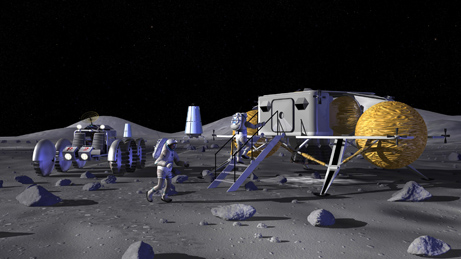'Lunar Ark' Proposed in Case of Deadly Impact on Earth
By 2024 NASA plans to set up a permanent outpost on the moon, as depicted in this artist's rendering.Some experts are also pushing for a "lunar ark" of human civilization to be kept on the base.
The ark would allow people to preserve humanity's learning, culture, and technology if Earth is hit by a doomsday asteroid or comet.

The moon should be developed as a sanctuary for civilization in case of a cataclysmic cosmic impact, according to an international team of experts.
NASA already has blueprints to create a permanent lunar outpost by the 2020s.
But that plan should be expanded to include a way to preserve humanity's learning, culture, and technology if Earth is hit by a doomsday asteroid or comet, said Jim Burke, a scientist at NASA's Jet Propulsion Laboratory in California.
Burke, a project manager on some of the earliest American lunar landings, now heads an International Space University study on surviving a collision with a near-Earth object.
An impact of the size that wiped out the dinosaurs hasn't happened since long before the rise of humans, he pointed out.
Yet scientists' expanding knowledge of asteroids and craters left throughout the solar system has created a consensus that Earth remains vulnerable to a civilization-crushing collision.
This calls for the creation of a space age Noah's ark, Burke said.
Lunar Ark
Humans are just beginning to send trinkets of technology and culture into space. NASA's recently launched Phoenix Mars Lander, for example, carries a mini-disc inscribed with stories, art, and music about Mars.
The Phoenix lander is a "precursor mission" in a decades-long project to transplant the essentials of humanity onto the moon and eventually Mars.
The International Space University team is now on a more ambitious mission: to start building a "lunar biological and historical archive," initially through robotic landings on the moon.
Laying the foundation for "rebuilding the terrestrial Internet, plus an Earth-moon extension of it, should be a priority," Burke said.
The founders of the group Alliance to Rescue Civilization (ARC) agreed that extending the Internet from the Earth to the moon could help avert a technological dark age following "nuclear war, acts of terrorism, plague, or asteroid collisions."
But the group also advocates creating a moon-based repository of Earth's life, complete with human-staffed facilities to "preserve backups of scientific and cultural achievements and of the species important to our civilization," said ARC's Robert Shapiro, a biochemist at New York University.
If the international lunar outpost of the 2020s expands into a colony and then a city, "it is possible that a whole new phase in civilization may develop—the branching of history into one stream on Earth and another on the moon," Burke, of NASA, added.
This "dual-world expansion" could be within reach by the end of this century, he said.
"Look at the last century, when we went from the Wright brothers to the Apollo missions—along with man's great expansion of his understanding of the cosmos."
Plan B?
Kilian Engel, an instructor at the International Space University who is involved in post-doomsday research, said the lunar archive is actually Plan B.
"Plan A involves creating an international network of astronomers to scan space for asteroids and comets that might threaten Earth, a global task force to formulate a strategy to prevent impacts with the planet, and a new generation of spacecraft to carry out these missions," Engel said.
More awareness of the danger posed by asteroids and comets is now spreading across the United States and the world.
In 2005 Congress directed NASA to figure out how to survey space for threatening near-Earth objects, as well as how to develop spacecraft to deflect or shoot them out of space.
Yet NASA receives less than five million U.S. dollars per year to conduct this "Spaceguard Survey," which is aimed at finding near-Earth objects greater than .62 miles (a kilometer) in diameter.
NASA has reviewed options that range from building titanic space tugboats to nudge asteroids off a collision course with Earth to crashing "kinectic impactors" into an oncoming comet.
Nuke Option
In March 2007 researchers at NASA's Near-Earth Object Program released a report that said nuclear explosions are ten to a hundred times more effective in diverting killer asteroids than non-nuclear alternatives.
Even so, "30 to 80 percent of potentially hazardous near-Earth objects are in orbits that are beyond the capability of current or planned launch systems," the report said.
And even if NASA eventually develops a nuclear-tipped, anti-asteroid launch vehicle, rocketing hydrogen bombs into space "is prohibited by the Outer Space Treaty of 1967," Burke said.
That UN-brokered treaty prohibits the deployment of nuclear weapons in Earth orbit, in outer space, or on any other celestial body.
Yet as astronomers across the globe piece together predictions on potential asteroids of mass destruction, UN members could vote to amend the space treaty to prepare a nuclear response to such threats.
Article by: Kevin Holden Platt
NGC
Subscribe to:
Post Comments
(
Atom
)



No comments :
Post a Comment